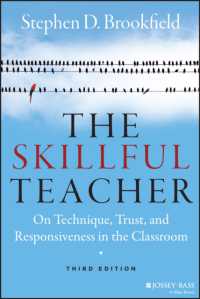Full Description
The goal of this book is to help teachers assess where they are in their current teaching goals and become more intentional and organized in planning. Teachers can begin with tools they already have and build on previous activities that worked well. Great lesson planning helps teachers to choose a range of strategies that match what children are learning and doing —from directed mini-lessons to facilitated group activities. Each chapter provides a wealth of tips and ideas. The strategies discussed in each chapter helps build a toolbox with tips that match each teacher's approach.
Child-centered lesson planning provides a system to strengthen teaching. In each chapter contains step-by-step hints and action steps to make the most of your unique setting. You will explore new ways to:
Build on early learning guidelines and standards to maximize planning and communication.
Identify learning goals for materials, activities, routines, and interactions.
Design dramatic play themes that relate to daily life, families, cultures, and communities.
Infuse vocabulary to scaffold language development.
Support executive function skills and self-regulation.
Activate emotion coaching goals.
Evaluate and adapt spaces and materials to address physical needs.
Meet the linguistic and social needs of dual language learners.
Prepare meaningful and stimulating cognitive experiences.
Connect content skills, language, and literacy to dramatic play.
Integrate family engagement as a strength and asset for development and learning.
Communicate effectively with colleagues to ensure high-quality learning experiences.
Contents
Introduction
Chapter 1: Setting a Foundation for Teaching
Celebrating How Children Learn
Tips for Teaching: Learning by Observing
Helping Children Thrive with Developmentally Appropriate Practice
Balance Points: Using Reflective Practice
Connecting Teaching to Children's Lives
Individualized Teaching: Using a Strengths-Based Approach
Ready Resources: Exploring Your Community Context
Understanding the Role of Play in Development
Teaching with Children in Mind
Helpful Hint: Following the Children's Lead
Research Connections: Strategies for Inclusion
Exploring Elements of Child-Centered Teaching
Sample Lesson Plans: Planning a Child-Centered Daily Schedule
Links to NAEYC Early Learning Program Accreditation Standards and Assessment Items
Reflection Questions
Chapter 2: Making Lesson Planning Work for You
Engaging Children in Active Learning
Balance Points: Positive Communication with Children
Planning a Variety of Teaching Contexts
Tips for Teaching: Creating a Rich Context for Learning
Individualized Teaching: Planning Personal Conversation
Exploring Levels of Support in Child-Centered Teaching
Ready Resources: Exploring Emergent Curriculum
Tips for Teaching: Effective Strategies to Support Child-Centered Learning
Helpful Hint: Adding Teaching Strategies to Lesson Planning
Being Consistent While Staying Flexible
Tips for Teaching: Getting Organized and Staying Inspired
Research Connections: Increasing Opportunities for Learning
Helpful Hint: Planning Materials for Play
Sample Lesson Plans: Planning Thematic Play Experiences
Links to NAEYC Early Learning Program Accreditation Standards and Assessment Items
Reflection Questions
Chapter 3: Preparing Child-Centered Themes and Play Areas
Identifying Learning Goals for Play
Recognizing Interdependence Among Areas of Development and Learning
Supporting Emerging Skills and Dispositions
Ready Resources: Exploring Standards and Early Learning Guidelines
Digging Deeper with Content Skills for Child-Centered Teaching
Helpful Hint: Considering the What, How, and Where of Play Areas
Research Connections: Creating Active Learners
Fostering Language Development During Play
Tips for Teaching: Maximizing Language Support
Helpful Hint: Making Play More Complex
Balance Points: Planning Effective Behavior Guidance During Play
Providing a Rich Context for Multilingual Learning
Ready Resources: Strategies for Multilingual Learners
Using Individualized Support
Tips for Teaching: Supporting Children with Special Needs
Ready Resources: Key Components of Inclusive Programs
Sample Lesson Plans: Connecting Learning Across Content Areas
Sample Book Lists: Aiming for Big Ideas and Concepts
Links to NAEYC Early Learning Program Accreditation Standards and Assessment Items
Reflection Questions
>Chapter 4: Planning Teacher-Directed Activities
Introducing New Information
Tips for Teaching: Connecting to Children's Daily Lives
Engaging Children in Higher-Level Thinking
Tips for Teaching: Choosing a Method and Activity
Following a Sequence of Planning
Tips for Teaching: Infusing the Joy of Writing
Research Connections: Creating a Rich Contact Zone for Learning
Teaching Children with Special Needs
Individualized Teaching: Writing Personalized Supports
Making the Most of Learning Objectives
Helpful Hint: Being Proactive
Ready Resources: Maximizing Vocabulary in Content Areas
Sample Lesson Plans: Teacher-Directed Learning
Links to NAEYC Early Learning Program Accreditation Standards and Assessment Items
Reflection Questions
Chapter 5: Using Observation, Documentation, and Assessment to Guide Teaching
Understanding Assessment with Young Children
Tips for Teaching: Exploring and Using Data
Understanding the Assessment Cycle
Research Connections: Identifying Equity Issues
Benefiting from Authentic Assessment
Exploring Types of Authentic Assessment
Assessing and Supporting Children Who Are Linguistically Diverse
Balance Points: Seeing from the Child's Point of View
Ready Resources: Building on Developmental Milestones
Ready Resources: Understanding Early Screening and Intervention
Helpful Hint: Sharing Assessment Information with Families
Committing to Ethical Practice
Links to NAEYC Early Learning Program Accreditation Standards and Assessment Items
Reflection Questions
Chapter 6: Enriching Communication with Families and Colleagues
Planning and Communication as Anchors of High Quality
Research Connections: Strengthening Teaching with Family Engagement
Sharing Information Using Strengths-Based Language
Tips for Teaching: Foundations for Integrating Culture
Ready Resources: Ensuring Equity and Opportunity
Enjoying Relationship-Based Teaching and Learning
Tips for Teaching: Communicating with Colleagues
Setting Goals, Establishing Priorities, and Sharing Progress
Balance Points: Self-Regulation and Behavior
Building Family Engagement Using Lesson Plans
Helpful Hint: Strategies for Positive Impact
Ready Resources: Family Engagement for Successful Teaching
Sample Lesson Plans: Family Interview Questions
Links to NAEYC Early Learning Program Accreditation Standards and Assessment Items
Reflection Questions
References
About the Author
Index








